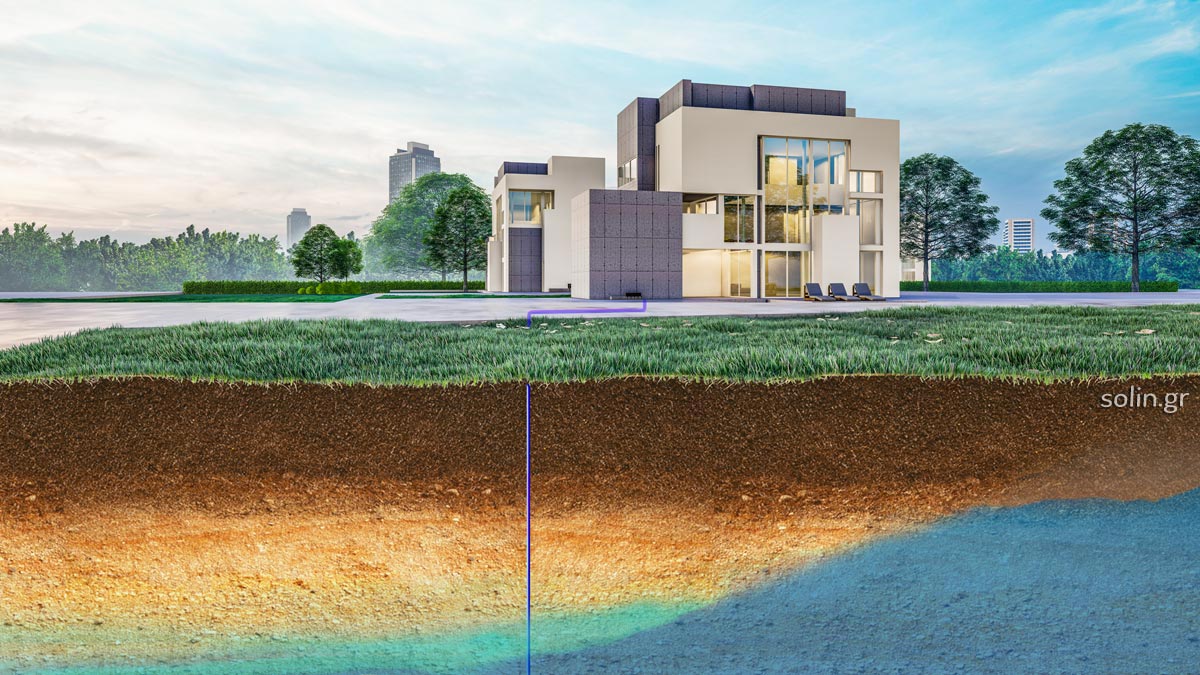GEOTHERMY
Geothermal energy is the stored energy, in the form of heat, beneath earth's surface. Geothermal energy is based on the fact that the temperature of the subsoil is kept constant throughout the year, without being affected by external conditions.
Geothermal energy is a renewable and therefore inexhaustible source of energy, which is provided free of charge by nature and is environmentally friendly. Taking advantage of the constant temperature offered by the subsoil, regardless of the season, with the use of geothermal heat pumps (GHP) and a network of underground piping, we can cover the heating needs of a building in winter, cooling in summer and hot water for domestic use. It reduces the operating costs of heating and cooling and performs better with underfloor heating, having the ability to use the sun as an additional energy source.
Among renewable energy sources, it ranks third, after hydropower and biomass. Geothermal has the highest use/operation factor (45%-90% of the time). That means that it does not depend on the weather conditions (apnea or cloud cover), specific times of the day (night) or seasons of the year (with biomass deficit). In this regard, geothermal energy can act as an energy station, replacing polluting hydrocarbon plants. Moreover, it has the lowest current and future investment and operating costs, and has zero environmental costs, since the limited area of above-ground installations (geothermal platforms) can be easily adapted to the landscape.
The categories of geothermal systems are:
OPEN GEOTHERMAL SYSTEM
If in the area applied, there are rich water deposits, then the open geothermal system is applied. This system exploits the groundwater temperature through two hydrogeoholes. One of them pumps the circulating water in the exchanger and is called pumping hydrogeohole and the other one returns the water back to the aquifer after the heat has been extracted and is called enrichment hydrogeohole. In areas near the sea where there is brackish water, a geothermal system can be used with the additional installation of salt protection equipment. If a geothermal system is required near to a sea or lake, the water can be pumped from the aquifer. Although this system is more economical in construction and has minimal land space requirements, it requires regular maintenance, depending on the quality of the water.

CLOSED HORIZONTAL GEOTHERMAL SYSTEM
In areas with little water supply, soil heat can be used with closed geothermal system. Its operation is similar to the open, but the difference is that instead of a hydrogeohole system, a closed circuit of pipelines is applied, the geoexchanger in which a special water solution with coolant is circulated, that absorbs or expels heat, depending on the season. Two subcategories predominate in the case of the closed system. If there is a large space, the surface layer of the ground is exploited to a depth of between 1,5 and 3 metres. In this case the pipes are horizontally in the ground and are called horizontal geoexchanger. The coils of the pipe must be placed with a certain distance between them. The required pipe laying area is calculated on the basis of the thermal and cooling requirements of the space. If the space is limited, the pipes of the geothermal heat exchanger are applied vertically at a depth of 30 to 100 meters and called vertical geoexchanger. The efficiency of the horizontal geoexchanger is 25-30 w/m. Restrictions may be due to the geological characteristics of the subsoil (e.g. if it is particularly rocky). This system is the most economical for construction between the two closed geothermal systems,, that’s why it is more often used , with the presupposition that the space of the area is sufficient.

CLOSED VERTICAL GEOTHERMAL SYSTEM
When the area of the plot is not sufficient for a horizontal geoexchanger or the composition of the subsoil is not suitable the vertical geoexchanger is applied .Each borehole has a depth of 70-100m. The distance between the boreholes should not be less than 5m to avoid local thermal saturation of the subsoil. The number of boreholes depends on the required power capacity of the installation. Each vertical geoexchanger has an average efficiency of 40-50w/m.
Depending on the operating pressure the pipes used in this system are AQUAFLEX (PE80 or PE100).



